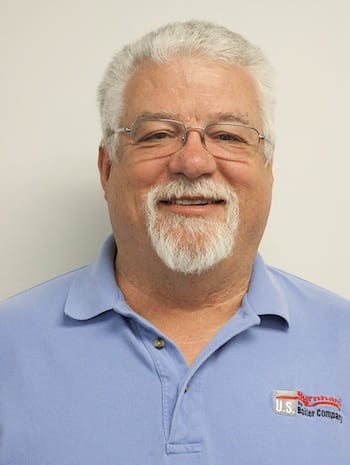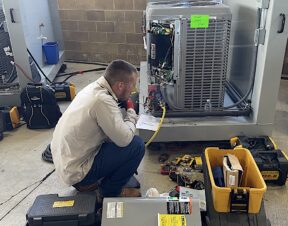 What??? I hear this often. How about “It gets too cold here for OD reset”. Or even “I love OD reset, but I don’t understand how to adjust it.” Maybe even “I always get complaints from my customers that “the radiation is not hot enough since the new boiler went in” and one more, “It doesn’t work with this type of system”.
What??? I hear this often. How about “It gets too cold here for OD reset”. Or even “I love OD reset, but I don’t understand how to adjust it.” Maybe even “I always get complaints from my customers that “the radiation is not hot enough since the new boiler went in” and one more, “It doesn’t work with this type of system”.
So, let me ask you what kind of hot water system you know of where outdoor reset will not work? I’ll answer this with one word…..None.
OD reset works with all types of hot water systems. But anyway, a quick review; what benefit does OD reset provide? It saves fuel and creates higher comfort levels in the building, not to mention reducing short cycles. It does so by changing the system’s supply water temperature depending on the current outdoor conditions. A few things come into play here: heat loss of the home (size and level of insulation), radiation (type and quantity), and of course, climate.
Those of you who’ve attended one of my seminars know that I’m a big proponent of reducing fuel bills by optimizing boiler and system efficiency. How do we do that? Proper boiler sizing and OD reset.
I believe that not using outdoor reset at every opportunity is doing a dis-service to your customers. US Boiler includes outdoor reset on our high efficiency modulation/condensing boilers, and we even offer it in a wireless version now. We even offer optional OD reset cards that simply plug into most of our cast iron boiler control systems. In fact, to achieve maximum efficiency of a condensing boiler, you must use OD reset. The lower the water temperature, the higher the boiler efficiency.
But, back to the misconception that there are applications where outdoor reset doesn’t work. Let’s touch on the different system types and utilizing OD reset. I’ll discuss four basic types of systems: radiant floors, cast iron radiation, copper fin-tube baseboard and hydro-air.
But before we get into it, let’s take a quick look at the default factory ODR settings on our boilers:
- Low OD air temperature – 0°F
- High OD air temperature – 70°F
- Low boiler temperature – 110°F
- High boiler temperature – 180°F
- Minimum water temperature – 130°F
Radiant floors are installed in numerous ways. There’s staple-up, where the tubing is fastened to the underside of the sub-floor with or without heat transfer plates. Sometimes tubing is installed above the subfloor, with a lightweight gypcrete pour overtop the tubing. Or it can be installed above the subfloor in grooves, with flooring installed on top of it without a gypcrete pour. And of course, tubing can be installed under a concrete slab.
To maintain setpoint temperature, all of these systems will require different temperatures. The more mass and insulation below the tubing, the lower the required water temperature. And, with outdoor reset, all of these applications will provide efficient boiler operation. We could easily see water temperatures as low as 80°F or as high as 160°F. You may have to change the low boiler temperature, minimum water temperature and possibly the high boiler temperature depending on the specific application.
The folks that say they don’t need ODR on a radiant system claim that the slab’s thermal mass is enough to flywheel the system through outdoor temperature swings, and that the slab doesn’t respond quickly enough to make a difference, even with fluctuating supply water temperatures. It’s true that a radiant system doesn’t respond as quickly as copper fin-tube, for example, and yes, the thermal mass of the slab will hold a more constant room temperature.
But those are both comfort considerations, and while they’re important, they completely overlook the fact that even with an in-slab system, if the water temperature is too high, the boiler will be short cycling and burning more fuel than needed.
Keep in mind, because radiant systems are lower temperature by nature, you might need to change the default ADR settings
Cast iron radiation, contrary to popular belief, is low-temperature heating, especially in modern homes. Sure back in the heyday of standing cast iron radiators, they might have needed 170 degree water. With single pane, wooden frame windows and zero insulation in the walls and ceilings, homes had HUGE heat loads. Now, insulate that same house and install new windows, and what do you have? Probably about half the heat load, at most. But the cast iron radiators haven’t shrunk, so you’ll be overheating the home or short-cycling the boiler. Probably both…. Unless of course there was a way to drop the water temperature…. Ahhhh. Yes. Outdoor reset control.
I’ve been asked many times about what water temperature a cast iron systems requires. My answer is always the same: “That depends”. There’s a lot of mass and high water volume, so, if it’s an insulated home, the temperature likely doesn’t need to be very high. Despite that, I’ve seen plenty of cast iron jobs where none of the boiler settings were changed from factory settings.
In most cast iron applications where home has some insulation, I usually like to see the low boiler temperature, minimum water temperature, and possibly the high boiler temperature reduced. Do the homework. Do a heat loss, calculate the water temperature required at design temperature with the amount of installed radiation. Once you have your design water temp, change the OD design temperature to 60°F on the heat loss and calculate the minimum water temperature. You may be really surprised. See the feature article this month for an Alpine installed in a cast iron radiation system. Cast iron radiators and stainless steel boilers work together beautifully, as long as outdoor rest is installed and properly adjusted.
Copper fin-tube baseboard, when connected to a high-efficiency boiler, means that OD reset is a must. Not only is copper baseboard a very responsive system, but the supply temperature needed will vary greatly depending on the ratio of baseboard to heat loss. Some systems can actually operate with supply temperatures under 180°F when it’s below 0°F outside.
I know of a baseboard job is Andover, Mass., with a high limit of 163°F. Despite the bitter cold spells we’ve seen in the past two years, the temperature has never needed to be raised. He’s running a minimum boiler temperature at 120°F instead of 130°F, and a low boiler water temperature of 100°F. Outdoor reset changes the supply temperature accordingly, and the home is always comfortable.
There are still folks out there who think condensing boilers should never be used with fin-tube baseboard, because these systems require high water temperatures. It’s true that fin-tube does require, on average, higher water temps than other systems. But it’s really only at design temperatures where a mod/con boiler wouldn’t condense. For the other 99% percent of the heating season, with an OD reset installed, the boiler will run at maximum efficiency. Fin-tube and condensing boilers go together like peas and carrots, but only with outdoor reset.
Hydro-air might just have the most misconceptions surrounding it. And that’s understandable, because bringing air movement into the equation does tend to make it a bit more difficult for wet-heads like us. But one thing is for certain, you can lower the supply water temperature to your coils when the outdoor temperature gets milder.
Don’t believe me? We’ve kept tabs on a few hydro-air jobs, and next month we’ll talk all about it.
Ron Beck is the outside Technical Advisor and manager of Training for U.S. Boiler Company, where he’s been since 1998. Ron’s 38 years of experience in the heating industry include climbing the ranks of a HVAC company, from apprentice to service manager. Ron writes contributes “Beck Tips” for the US Boiler Report. Beck Tips consist of a lot of helpful technical advice for installing hydronic systems (proper boiler sizing, piping, etc).




Join the conversation: